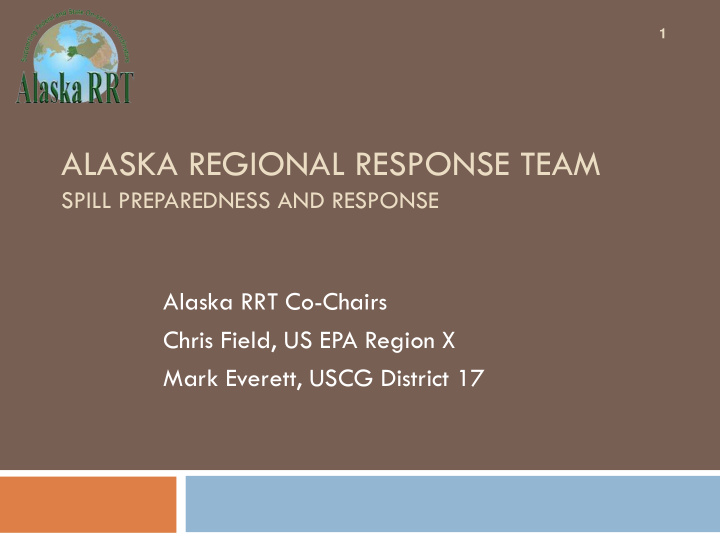



1 ALASKA REGIONAL RESPONSE TEAM SPILL PREPAREDNESS AND RESPONSE Alaska RRT Co-Chairs Chris Field, US EPA Region X Mark Everett, USCG District 17
What is the Alaska RRT? 2 Background Oil Pollution Act 1990 ARRT Membership ARRT Jurisdiction – Inland and Marine ARRT Roles
Alaska Regional Response Team (ARRT) 3 Standing vs Incident Specific RRT Tribal involvement State and local involvement
Contingency Plan Responsibilities 4 National National Contingency Plan NRT Regional Contingency Plan Regional (State) RRT Local (Subarea) Subarea Contingency Plans FOSC/Subarea Committee Vessel Facility Contingency Contingency Plans Plans
Alaska Unified Plan 5 What is it? Whose is it? Where do I find it? What is in it? When is it updated? www.alaskarrt.org
Contents of the Unified Plan 6 Response System Org • Public Affairs • Incident Command System • • Radiological Response Federal Funding Procedures • • MOU/MOAs Process for Updating • Response Equipment • HazMat • Alternative Countermeasures • • Historic Properties Wildlife Protection Guidelines • Protection Health, Safety, & Training • • Shoreline Assessment & Cleanup • Places of Refuge (POR) • Marine FF & Salvage • Volunteers
10 Subarea Contingency Plans 7
Subarea Contingency Plans 8 Where to find them? www.alaskarrt.org Key components and goals Area Committees Federal On-Scene Coordinator Geographic Response Strategies How can Tribes get involved?
Role of ARRT vs Subarea Committees 10 RRT Subarea Committee Chaired by FOSCs and SOSCs Co-Chaired by EPA and Development and maintenance of USCG effective Subarea Plans Plan revisions and consistency [VCPs, Support to FOSCs FCPs, OSRPs] Incident Activations Assimilation of Outreach to public and State, Tribe and Local Adherence to NCP responders/stakeholders Exercises Spill Response Policy FOSC Guidance Strategic Direction Leadership over workgroups and taskforces Drills and Exercises
When an Oil Spill Enters the Environment 11 Critical Decisions on Environmental Trade-off Unified Command Environmental Unit Tribes and Trustees Sensitive Areas Near shore vs deep water Surface vs subsurface risks and sensitivities Keeping oil off the shoreline
Oil Spill Response Options 12 National Contingency Plan, subpart J Removing oil from the environment by mechanical recovery is the preferred cleanup option, however due to limitations, all oil spill cleanup tools must be available. Mechanical oil recovery In Situ Burn Dispersants Bioremediation
Goal to Enhance Tribal Involvement 13 Tribal involvement is important in every facet of emergency planning and response Planning Join Subarea Committees Comment on Plans Identify sensitive areas and habitat Emergency Response Engage on Alaska RRT Get trained in the Incident Command System Identify Liaison Officer
Unified Command Diagram 14 Alaska RRT Supports UC FOSC SOSC LOSC RPIC Tribal Liaison Officer Safety Officer Liaison Officer Operations Planning Finance Logistics Tribal Environmental Environmental Unit (EU)
Questions…? 15 Alaska Regional Response Team November 2013
Recommend
More recommend